Building your Deep Neural Network: Step by Step
- 你将使用下面函数来构建一个深层神经网络来实现图像分类。
- 使用像relu这的非线性单元来改进你的模型
- 构建一个多隐藏层的神经网络(有超过一个隐藏层)
符号说明:

1 - Packages(导入的包)
- numpy:进行科学计算的包
- matplotlib :绘图包
- dnn_utils:提供一些必要功能
- testCases 提供一些测试用例来评估函数的正确性
- np.random.seed(1) 设置随机数种子,易于测试。
import numpy as np
import h5py
import matplotlib.pyplot as plt
from testCases_v2 import *
from dnn_utils_v2 import sigmoid, sigmoid_backward, relu, relu_backward
%matplotlib inline
plt.rcParams['figure.figsize'] = (5.0, 4.0) # 设置最大图像大小
plt.rcParams['image.interpolation'] = 'nearest'
plt.rcParams['image.cmap'] = 'gray'
%load_ext autoreload
%autoreload 2
np.random.seed(1)
保存在本地
# TODO: 保存在dnn_utils.py
import numpy as np
def sigmoid(Z):
"""
Implements the sigmoid activation in numpy
Arguments:
Z -- numpy array of any shape
Returns:
A -- output of sigmoid(z), same shape as Z
cache -- returns Z as well, useful during backpropagation
"""
A = 1/(1+np.exp(-Z))
cache = Z
return A, cache
def relu(Z):
"""
Implement the RELU function.
Arguments:
Z -- Output of the linear layer, of any shape
Returns:
A -- Post-activation parameter, of the same shape as Z
cache -- a python dictionary containing "A" ; stored for computing the backward pass efficiently
"""
A = np.maximum(0,Z)
assert(A.shape == Z.shape)
cache = Z
return A, cache
def relu_backward(dA, cache):
"""
Implement the backward propagation for a single RELU unit.
Arguments:
dA -- post-activation gradient, of any shape
cache -- 'Z' where we store for computing backward propagation efficiently
Returns:
dZ -- Gradient of the cost with respect to Z
"""
Z = cache
dZ = np.array(dA, copy=True) # just converting dz to a correct object.
# When z <= 0, you should set dz to 0 as well.
dZ[Z <= 0] = 0
assert (dZ.shape == Z.shape)
return dZ
def sigmoid_backward(dA, cache):
"""
Implement the backward propagation for a single SIGMOID unit.
Arguments:
dA -- post-activation gradient, of any shape
cache -- 'Z' where we store for computing backward propagation efficiently
Returns:
dZ -- Gradient of the cost with respect to Z
"""
Z = cache
s = 1/(1+np.exp(-Z))
dZ = dA * s * (1-s)
assert (dZ.shape == Z.shape)
return dZ
# TODO: testCases.py
import numpy as np
def linear_forward_test_case():
np.random.seed(1)
"""
X = np.array([[-1.02387576, 1.12397796],
[-1.62328545, 0.64667545],
[-1.74314104, -0.59664964]])
W = np.array([[ 0.74505627, 1.97611078, -1.24412333]])
b = np.array([[1]])
"""
A = np.random.randn(3,2)
W = np.random.randn(1,3)
b = np.random.randn(1,1)
return A, W, b
def linear_activation_forward_test_case():
"""
X = np.array([[-1.02387576, 1.12397796],
[-1.62328545, 0.64667545],
[-1.74314104, -0.59664964]])
W = np.array([[ 0.74505627, 1.97611078, -1.24412333]])
b = 5
"""
np.random.seed(2)
A_prev = np.random.randn(3,2)
W = np.random.randn(1,3)
b = np.random.randn(1,1)
return A_prev, W, b
def L_model_forward_test_case():
"""
X = np.array([[-1.02387576, 1.12397796],
[-1.62328545, 0.64667545],
[-1.74314104, -0.59664964]])
parameters = {'W1': np.array([[ 1.62434536, -0.61175641, -0.52817175],
[-1.07296862, 0.86540763, -2.3015387 ]]),
'W2': np.array([[ 1.74481176, -0.7612069 ]]),
'b1': np.array([[ 0.],
[ 0.]]),
'b2': np.array([[ 0.]])}
"""
np.random.seed(1)
X = np.random.randn(4,2)
W1 = np.random.randn(3,4)
b1 = np.random.randn(3,1)
W2 = np.random.randn(1,3)
b2 = np.random.randn(1,1)
parameters = {"W1": W1,
"b1": b1,
"W2": W2,
"b2": b2}
return X, parameters
def compute_cost_test_case():
Y = np.asarray([[1, 1, 1]])
aL = np.array([[.8,.9,0.4]])
return Y, aL
def linear_backward_test_case():
"""
z, linear_cache = (np.array([[-0.8019545 , 3.85763489]]), (np.array([[-1.02387576, 1.12397796],
[-1.62328545, 0.64667545],
[-1.74314104, -0.59664964]]), np.array([[ 0.74505627, 1.97611078, -1.24412333]]), np.array([[1]]))
"""
np.random.seed(1)
dZ = np.random.randn(1,2)
A = np.random.randn(3,2)
W = np.random.randn(1,3)
b = np.random.randn(1,1)
linear_cache = (A, W, b)
return dZ, linear_cache
def linear_activation_backward_test_case():
"""
aL, linear_activation_cache = (np.array([[ 3.1980455 , 7.85763489]]), ((np.array([[-1.02387576, 1.12397796], [-1.62328545, 0.64667545], [-1.74314104, -0.59664964]]), np.array([[ 0.74505627, 1.97611078, -1.24412333]]), 5), np.array([[ 3.1980455 , 7.85763489]])))
"""
np.random.seed(2)
dA = np.random.randn(1,2)
A = np.random.randn(3,2)
W = np.random.randn(1,3)
b = np.random.randn(1,1)
Z = np.random.randn(1,2)
linear_cache = (A, W, b)
activation_cache = Z
linear_activation_cache = (linear_cache, activation_cache)
return dA, linear_activation_cache
def L_model_backward_test_case():
"""
X = np.random.rand(3,2)
Y = np.array([[1, 1]])
parameters = {'W1': np.array([[ 1.78862847, 0.43650985, 0.09649747]]), 'b1': np.array([[ 0.]])}
aL, caches = (np.array([[ 0.60298372, 0.87182628]]), [((np.array([[ 0.20445225, 0.87811744],
[ 0.02738759, 0.67046751],
[ 0.4173048 , 0.55868983]]),
np.array([[ 1.78862847, 0.43650985, 0.09649747]]),
np.array([[ 0.]])),
np.array([[ 0.41791293, 1.91720367]]))])
"""
np.random.seed(3)
AL = np.random.randn(1, 2)
Y = np.array([[1, 0]])
A1 = np.random.randn(4,2)
W1 = np.random.randn(3,4)
b1 = np.random.randn(3,1)
Z1 = np.random.randn(3,2)
linear_cache_activation_1 = ((A1, W1, b1), Z1)
A2 = np.random.randn(3,2)
W2 = np.random.randn(1,3)
b2 = np.random.randn(1,1)
Z2 = np.random.randn(1,2)
linear_cache_activation_2 = ( (A2, W2, b2), Z2)
caches = (linear_cache_activation_1, linear_cache_activation_2)
return AL, Y, caches
def update_parameters_test_case():
"""
parameters = {'W1': np.array([[ 1.78862847, 0.43650985, 0.09649747],
[-1.8634927 , -0.2773882 , -0.35475898],
[-0.08274148, -0.62700068, -0.04381817],
[-0.47721803, -1.31386475, 0.88462238]]),
'W2': np.array([[ 0.88131804, 1.70957306, 0.05003364, -0.40467741],
[-0.54535995, -1.54647732, 0.98236743, -1.10106763],
[-1.18504653, -0.2056499 , 1.48614836, 0.23671627]]),
'W3': np.array([[-1.02378514, -0.7129932 , 0.62524497],
[-0.16051336, -0.76883635, -0.23003072]]),
'b1': np.array([[ 0.],
[ 0.],
[ 0.],
[ 0.]]),
'b2': np.array([[ 0.],
[ 0.],
[ 0.]]),
'b3': np.array([[ 0.],
[ 0.]])}
grads = {'dW1': np.array([[ 0.63070583, 0.66482653, 0.18308507],
[ 0. , 0. , 0. ],
[ 0. , 0. , 0. ],
[ 0. , 0. , 0. ]]),
'dW2': np.array([[ 1.62934255, 0. , 0. , 0. ],
[ 0. , 0. , 0. , 0. ],
[ 0. , 0. , 0. , 0. ]]),
'dW3': np.array([[-1.40260776, 0. , 0. ]]),
'da1': np.array([[ 0.70760786, 0.65063504],
[ 0.17268975, 0.15878569],
[ 0.03817582, 0.03510211]]),
'da2': np.array([[ 0.39561478, 0.36376198],
[ 0.7674101 , 0.70562233],
[ 0.0224596 , 0.02065127],
[-0.18165561, -0.16702967]]),
'da3': np.array([[ 0.44888991, 0.41274769],
[ 0.31261975, 0.28744927],
[-0.27414557, -0.25207283]]),
'db1': 0.75937676204411464,
'db2': 0.86163759922811056,
'db3': -0.84161956022334572}
"""
np.random.seed(2)
W1 = np.random.randn(3,4)
b1 = np.random.randn(3,1)
W2 = np.random.randn(1,3)
b2 = np.random.randn(1,1)
parameters = {"W1": W1,
"b1": b1,
"W2": W2,
"b2": b2}
np.random.seed(3)
dW1 = np.random.randn(3,4)
db1 = np.random.randn(3,1)
dW2 = np.random.randn(1,3)
db2 = np.random.randn(1,1)
grads = {"dW1": dW1,
"db1": db1,
"dW2": dW2,
"db2": db2}
return parameters, grads
2 - 任务概要
-
双隐藏层 和 L层神经网络 的 参数初始化。
-
实现前向传播操作(forward propagation) 。计算 损失函数。
-
完成 层的 前向传播 的 线性部分。(计算出 Z = WX + b) 。
-
使用 relu 和 sigmod 激活函数计算结果值。
-
将前两个步骤组合成一个新的前向函数(线性->激活) [LINEAR->ACTIVATION]
-
对输出层之前的 L-1 层,做 L-1 次 的 前向传播 [LINEAR->RELU] ,L层输出层的 激活函数 为 sigmod
-
计算损失函数(loss fun)
-
实现 后向传播操作 模块(在下图中用红色表示)。最后更新参数。
-
计算神经网络 反向传播的 LINEAR 部分。
-
计算 激活函数 (Relu 或者 sigmod)的 梯度。
-
综合前两个步骤,产生一个新的后向函数【Liner --> Activation】
-
更新参数
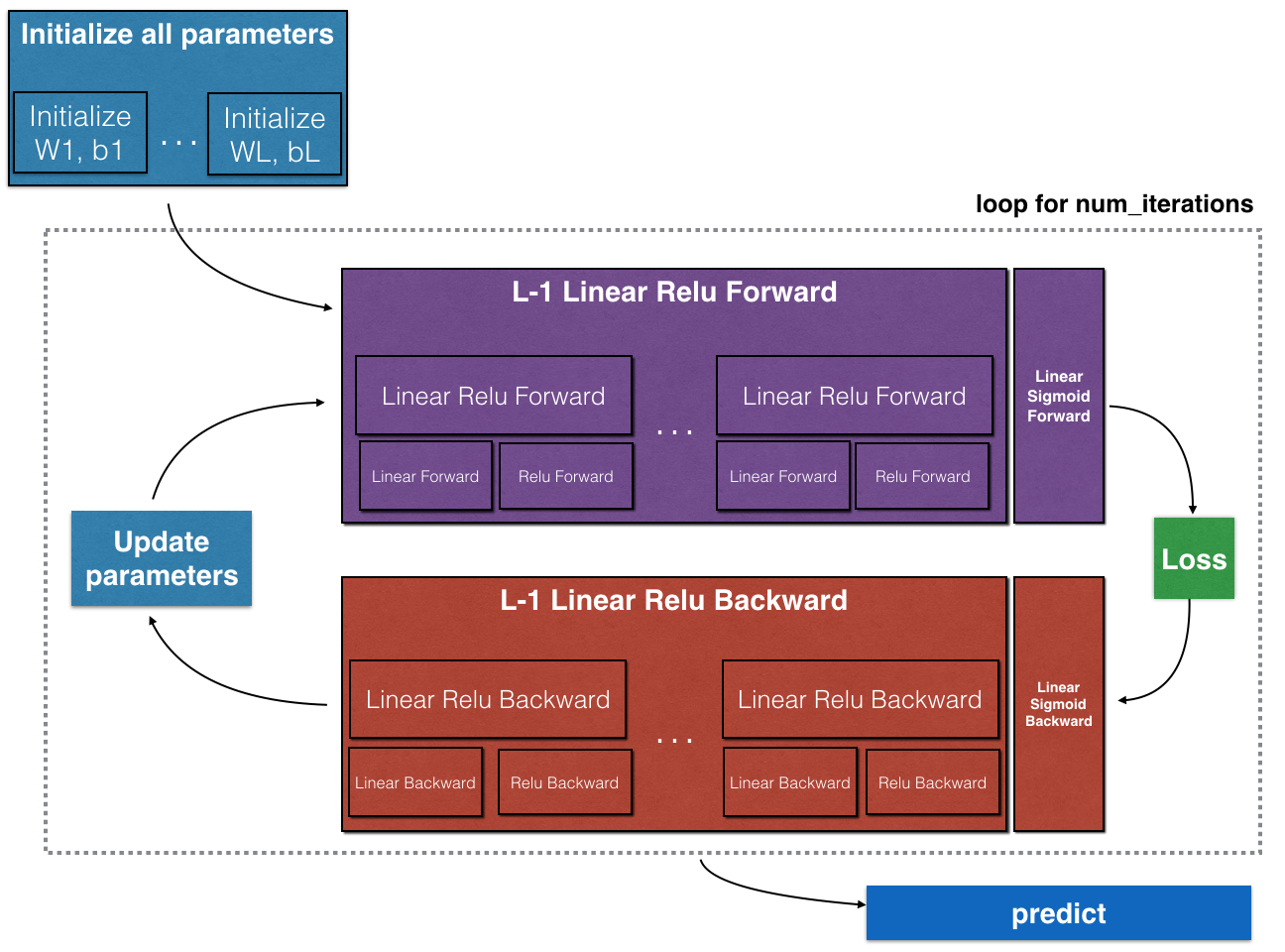
注意,前向函数和反向函数相对应。前向传播的每一步都将反向传播用的到值存储在cache。cache中值对于计算梯度非常有用。
3 - Initialization(初始化)
为你的模型编写函数初始化参数。第一个函数将用于 初始化两层模型 的参数。第二个函数用于 初始化 L层模型 的参数。
3.1 - 2-layer Neural Network (双隐藏层神经网络)
Exercise: 创建和初始化 2层神经网络 的参数.
Instructions:
- 模型结果: LINEAR -> RELU -> LINEAR -> SIGMOID.
- 使用 随机初始化 权重矩阵。用
np.random.randn(shape)*0.01用正确的shape。 - 使用 0 初始化偏差。用
np.zeros(shape)。
# GRADED FUNCTION: initialize_parameters
def initialize_parameters(n_x, n_h, n_y):
"""
Argument:
n_x -- size of the input layer
n_h -- size of the hidden layer
n_y -- size of the output layer
Returns:
parameters -- python dictionary containing your parameters:
W1 -- weight matrix of shape (n_h, n_x)
b1 -- bias vector of shape (n_h, 1)
W2 -- weight matrix of shape (n_y, n_h)
b2 -- bias vector of shape (n_y, 1)
"""
np.random.seed(1)
### START CODE HERE ### (≈ 4 lines of code)
W1 = np.random.randn(n_h, n_x)*0.01
b1 = np.zeros((n_h, 1))
W2 = np.random.randn(n_y, n_h)*0.01
b2 = np.zeros((n_y, 1))
### END CODE HERE ###
assert(W1.shape == (n_h, n_x))
assert(b1.shape == (n_h, 1))
assert(W2.shape == (n_y, n_h))
assert(b2.shape == (n_y, 1))
parameters = {"W1": W1,
"b1": b1,
"W2": W2,
"b2": b2}
return parameters
parameters = initialize_parameters(3,2,1)
print("W1 = " + str(parameters["W1"]))
print("b1 = " + str(parameters["b1"]))
print("W2 = " + str(parameters["W2"]))
print("b2 = " + str(parameters["b2"]))
W1 = [[ 0.01624345 -0.00611756 -0.00528172] [-0.01072969 0.00865408 -0.02301539]] b1 = [[ 0.] [ 0.]] W2 = [[ 0.01744812 -0.00761207]] b2 = [[ 0.]]
Expected output:
| W1 | [[ 0.01624345 -0.00611756 -0.00528172] [-0.01072969 0.00865408 -0.02301539]] |
| b1 | [[ 0.] [ 0.]] |
| W2 | [[ 0.01744812 -0.00761207]] |
| b2 | [[ 0.]] |
3.2 - L-layer Neural Network(L-层隐藏层神经网络)
当完成 initialize_parameters_deep 时,你应该确保每个层之间的维度匹配。n^l 是 L层中单位数。如,输入X,size = (12288, 209)(有m=209个样本):

Exercise: 实现 L层神经网络的 初始化。
Instructions:
- 模型结构:[LINEAR -> RELU] × (L-1) --> LINEAR -> SIGMOID. , 所以 L-1 层是需要用 ReLu激活函数,输出层是用 sigmod函数。
- 权重矩阵采用 随机初始化的 方式:用
np.random.randn(shape) * 0.01. - 偏移矩阵仍是 0 矩阵进行初始化:用
np.zeros(shape). - 我们将每层神经元数量
 信息进行存储,layer_dims。例如,在平面数据分类模型中 layer_dims 的值是 [2, 4, 1]:
信息进行存储,layer_dims。例如,在平面数据分类模型中 layer_dims 的值是 [2, 4, 1]:
- 其中 输入层的神经元个数是2,一个隐藏层的神经元个数是 4,输出层的神经元个数是1。
- 对应 W1.shape = (4, 2), b1.shape = (4, 1), W2.shape = (1, 4), b2.shape = (1, 1)。
- 下面是实现 L=1 层神经网络:
if L == 1:
parameters["W" + str(L)] = np.random.randn(layer_dims[1], layer_dims[0]) * 0.01
parameters["b" + str(L)] = np.zeros((layer_dims[1], 1))
- L 层神经网络实现方式(参数初始化):
# GRADED FUNCTION: initialize_parameters_deep
def initialize_parameters_deep(layer_dims):
"""
Arguments:
layer_dims -- python array (list) containing the dimensions of each layer in our network
Returns:
parameters -- python dictionary containing your parameters "W1", "b1", ..., "WL", "bL":
Wl -- weight matrix of shape (layer_dims[l], layer_dims[l-1])
bl -- bias vector of shape (layer_dims[l], 1)
"""
np.random.seed(3)
parameters = {}
L = len(layer_dims) # number of layers in the network
for l in range(1, L):
### START CODE HERE ### (≈ 2 lines of code)
parameters['W' + str(l)] = np.random.randn(layer_dims[l], layer_dims[l - 1]) * 0.01
parameters['b' + str(l)] = np.zeros((layer_dims[l], 1))
### END CODE HERE ###
assert(parameters['W' + str(l)].shape == (layer_dims[l], layer_dims[l-1]))
assert(parameters['b' + str(l)].shape == (layer_dims[l], 1))
return parameters
parameters = initialize_parameters_deep([5,4,3])
print("W1 = " + str(parameters["W1"]))
print("b1 = " + str(parameters["b1"]))
print("W2 = " + str(parameters["W2"]))
print("b2 = " + str(parameters["b2"]))
Expected output:
| W1 | [[ 0.01788628 0.0043651 0.00096497 -0.01863493 -0.00277388] [-0.00354759 -0.00082741 -0.00627001 -0.00043818 -0.00477218] [-0.01313865 0.00884622 0.00881318 0.01709573 0.00050034] [-0.00404677 -0.0054536 -0.01546477 0.00982367 -0.01101068]] |
| b1 | [[ 0.] [ 0.] [ 0.] [ 0.]] |
| W2 | [[-0.01185047 -0.0020565 0.01486148 0.00236716] [-0.01023785 -0.00712993 0.00625245 -0.00160513] [-0.00768836 -0.00230031 0.00745056 0.01976111]] |
| b2 | [[ 0.] [ 0.] [ 0.]] |
4 - Forward propagation module(前向传播模型)
三个部分:
-
实现线性函数 (Z = np.dot(W, A) + b)
-
使用激励函数(Relu or Sigmod)
-
应用到整个模型
4.1 - Linear Forward
前向传播的过程,先计算如下的线性部分: 。其中,
。其中,
Exercise: 建立前向传播的线性部分。
# GRADED FUNCTION: linear_forward
def linear_forward(A, W, b):
"""
Implement the linear part of a layer's forward propagation.
Arguments:
A -- activations from previous layer (or input data): (size of previous layer, number of examples)
W -- weights matrix: numpy array of shape (size of current layer, size of previous layer)
b -- bias vector, numpy array of shape (size of the current layer, 1)
Returns:
Z -- the input of the activation function, also called pre-activation parameter
cache -- a python dictionary containing "A", "W" and "b" ; stored for computing the backward pass efficiently
"""
### START CODE HERE ### (≈ 1 line of code)
Z = np.dot(W, A) + b
# print("W: ", W.shape)
# print("A: ", A.shape)
# print("b: ", b.shape)
### END CODE HERE ###
assert(Z.shape == (W.shape[0], A.shape[1]))
cache = (A, W, b)
return Z, cache
A, W, b = linear_forward_test_case()
Z, linear_cache = linear_forward(A, W, b)
print("Z = " + str(Z))
Expected output:
| Z | [[ 3.26295337 -1.23429987]] |
4.2 - 激活函数(相邻两层的激活实现)
你要使用的两个激励函数:

Exercise: 实现前向传播(LINEAR->ACTIVATION layer)。数学公式是: ,激励函数“g”是 sigmod 或者 relu()。使用 linear_forward() 和 正确的 激励函数。
,激励函数“g”是 sigmod 或者 relu()。使用 linear_forward() 和 正确的 激励函数。
//预先实现的 sigmod 和 relu 函数
import numpy as np
def sigmoid(Z):
"""n
Implements the sigmoid activation in numpy
Arguments:
Z -- numpy array of any shape
Returns:
A -- output of sigmoid(z), same shape as Z
cache -- returns Z as well, useful during backpropagation
"""
A = 1/(1+np.exp(-Z))
cache = Z
return A, cache
def relu(Z):
"""
Implement the RELU function.
Arguments:
Z -- Output of the linear layer, of any shape
Returns:
A -- Post-activation parameter, of the same shape as Z
cache -- a python dictionary containing "A" ; stored for computing the backward pass efficiently
"""
A = np.maximum(0,Z)
assert(A.shape == Z.shape)
cache = Z
return A, cache
//linear_activation_forward()
# GRADED FUNCTION: linear_activation_forward
def linear_activation_forward(A_prev, W, b, activation):
"""
Implement the forward propagation for the LINEAR->ACTIVATION layer
Arguments:
A_prev -- activations from previous layer (or input data): (size of previous layer, number of examples)
W -- weights matrix: numpy array of shape (size of current layer, size of previous layer)
b -- bias vector, numpy array of shape (size of the current layer, 1)
activation -- the activation to be used in this layer, stored as a text string: "sigmoid" or "relu"
Returns:
A -- the output of the activation function, also called the post-activation value
cache -- a python dictionary containing "linear_cache" and "activation_cache";
stored for computing the backward pass efficiently
"""
if activation == "sigmoid":
# Inputs: "A_prev, W, b". Outputs: "A, activation_cache".
### START CODE HERE ### (≈ 2 lines of code)
Z, linear_cache = linear_forward(A_prev, W, b) # linear_cache:A_prev, W, b
A, activation_cache = sigmoid(Z) # activation_cache:Z
### END CODE HERE ###
elif activation == "relu":
# Inputs: "A_prev, W, b". Outputs: "A, activation_cache".
### START CODE HERE ### (≈ 2 lines of code)
Z, linear_cache = linear_forward(A_prev, W, b)
A, activation_cache = relu(Z)
### END CODE HERE ###
assert (A.shape == (W.shape[0], A_prev.shape[1]))
cache = (linear_cache, activation_cache)
return A, cache
A_prev, W, b = linear_activation_forward_test_case()
A, linear_activation_cache = linear_activation_forward(A_prev, W, b, activation = "sigmoid")
print("With sigmoid: A = " + str(A))
A, linear_activation_cache = linear_activation_forward(A_prev, W, b, activation = "relu")
print("With ReLU: A = " + str(A))
Expected output:
| With sigmoid: A | [[ 0.96890023 0.11013289]] |
| With ReLU: A | [[ 3.43896131 0. ]] |
4.3 - L-Layer Model (L层模型)
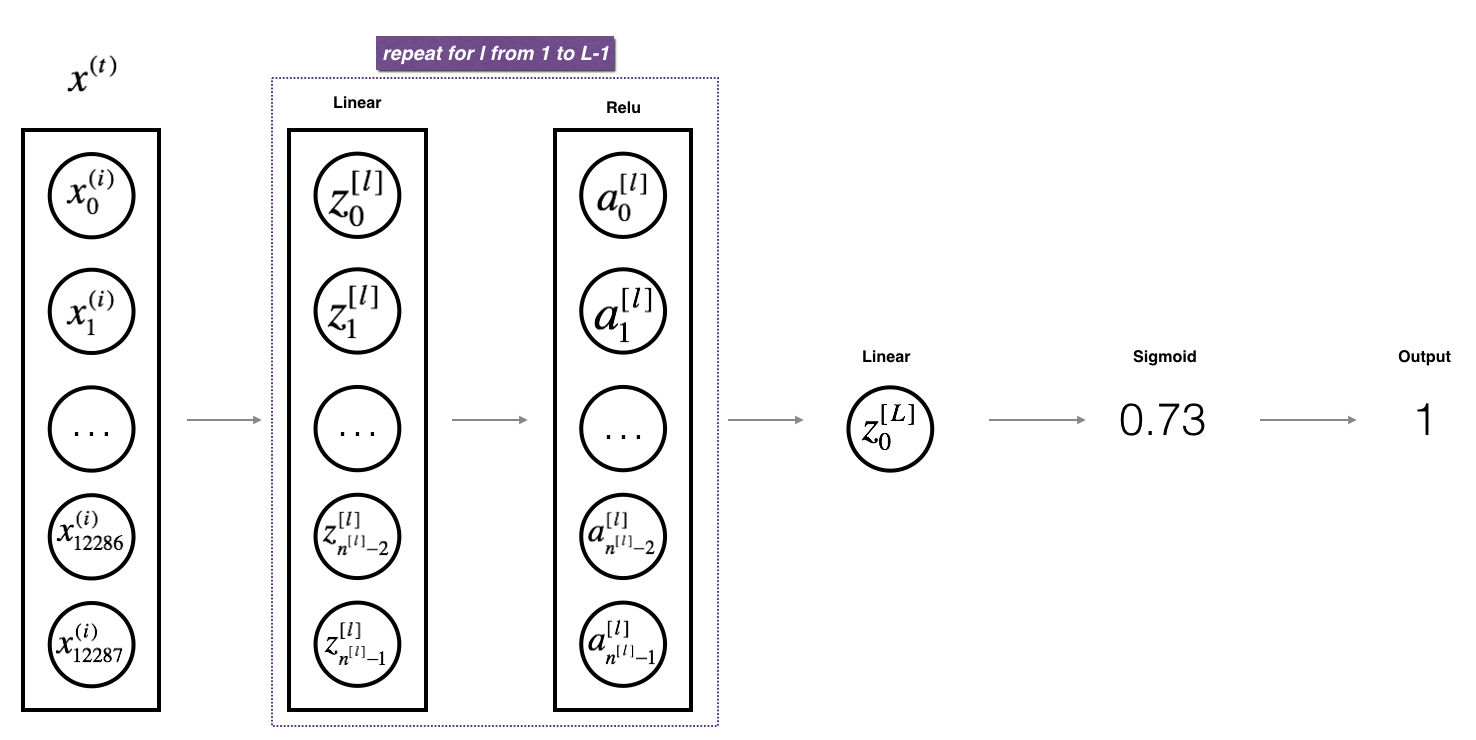
[Linear -> Relu] x (L - 1) --> Linear--> Sigmod model
Exercise: 实现以上 前向传播模型
Instruction: AL: ,AL有时候叫做:
,AL有时候叫做:
Tips:
- 使用之前用的函数
- 使用循环重复 【Linear --> Relu】(L-1)次
- 不要忘记跟踪"cache"列表中的cache。添加 c 到 list。用
list.append(c).
# GRADED FUNCTION: L_model_forward
def L_model_forward(X, parameters):
"""
Implement forward propagation for the [LINEAR->RELU]*(L-1)->LINEAR->SIGMOID computation
Arguments:
X -- data, numpy array of shape (input size, number of examples)
parameters -- output of initialize_parameters_deep()
Returns:
AL -- last post-activation value
caches -- list of caches containing:
every cache of linear_activation_forward() (there are L-1 of them, indexed from 0 to L-1)
"""
caches = []
A = X
L = len(parameters) // 2 # number of layers in the neural network
# Implement [LINEAR -> RELU]*(L-1). Add "cache" to the "caches" list.
for l in range(1, L):
A_prev = A
### START CODE HERE ### (≈ 2 lines of code)
A, cache = linear_activation_forward(A_prev,
parameters["W" + str(l)],
parameters["b" + str(l)],
activation='relu') # cache = (A W b, Z)
caches.append(cache)
### END CODE HERE ###
# Implement LINEAR -> SIGMOID. Add "cache" to the "caches" list.
### START CODE HERE ### (≈ 2 lines of code)
AL, cache = linear_activation_forward(A,
parameters["W" + str(L)],
parameters["b" + str(L)],
activation="sigmoid")
caches.append(cache)
### END CODE HERE ###
assert(AL.shape == (1,X.shape[1]))
return AL, caches
X, parameters = L_model_forward_test_case()
AL, caches = L_model_forward(X, parameters)
print("AL = " + str(AL))
print("Length of caches list = " + str(len(caches)))
AL = [[ 0.17007265 0.2524272 ]]
Length of caches list = 2
5 - Cost function(代价函数)
Exercise: 计算代价函数:

# GRADED FUNCTION: compute_cost
def compute_cost(AL, Y):
"""
Implement the cost function defined by equation (7).
Arguments:
AL -- probability vector corresponding to your label predictions, shape (1, number of examples)
Y -- true "label" vector (for example: containing 0 if non-cat, 1 if cat), shape (1, number of examples)
Returns:
cost -- cross-entropy cost
"""
m = Y.shape[1]
# Compute loss from aL and y.
### START CODE HERE ### (≈ 1 lines of code)
cost = - (1 / m) * np.sum(np.multiply(Y, np.log(AL)) + np.multiply(1 - Y, np.log(1 - AL)))
### END CODE HERE ###
cost = np.squeeze(cost) # To make sure your cost's shape is what we expect (e.g. this turns [[17]] into 17).
assert(cost.shape == ())
return cost
Y, AL = compute_cost_test_case()
print("cost = " + str(compute_cost(AL, Y)))
Expected Output:
| cost | 0.41493159961539694 |
6 - Backward propagation module(反向传播模型)
- 反向传播用于计算损失函数相对于参数的梯度
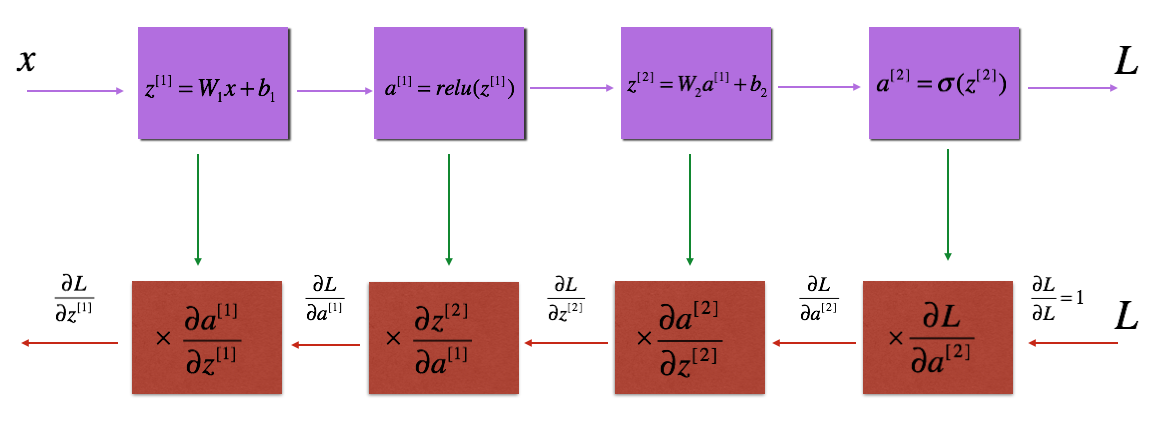
Figure3:紫色部分:前向传播;红色部分:反向传播;
建立反向传播3个步骤:
- Linear backward
- Linear--> Activation backward (activation 计算Relu 或者sigmod的导数)
- [Linear-->Relu] x (L-1) --> Linear --> Sigmod backward (整个模型)
6.1 - Linear backward (反向传播线性部分)
- 对
 层,线性部分是:
层,线性部分是:
![]()
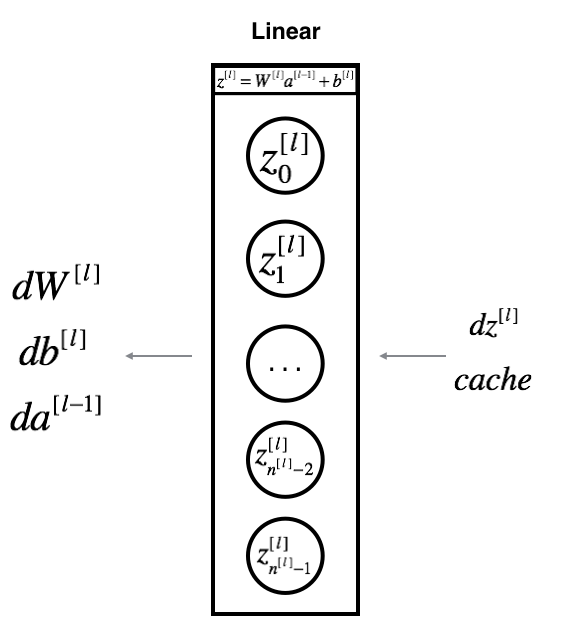
注:cache提供 tuple值 -- (A_prev, W, b)


Exercise: 使用上面三个公式实现反向传播的线性部分: linear_backward().
# GRADED FUNCTION: linear_backward
def linear_backward(dZ, cache):
"""
Implement the linear portion of backward propagation for a single layer (layer l)
Arguments:
dZ -- Gradient of the cost with respect to the linear output (of current layer l)
cache -- tuple of values (A_prev, W, b) coming from the forward propagation in the current layer
Returns:
dA_prev -- Gradient of the cost with respect to the activation (of the previous layer l-1), same shape as A_prev
dW -- Gradient of the cost with respect to W (current layer l), same shape as W
db -- Gradient of the cost with respect to b (current layer l), same shape as b
"""
A_prev, W, b = cache
m = A_prev.shape[1]
### START CODE HERE ### (≈ 3 lines of code)
dW = (1 / m) * np.dot(dZ, A_prev.T)
db = (1 / m ) * np.sum(dZ, axis=1, keepdims=True)
dA_prev = np.dot(W.T, dZ)
### END CODE HERE ###
assert (dA_prev.shape == A_prev.shape)
assert (dW.shape == W.shape)
assert (db.shape == b.shape)
return dA_prev, dW, db
# Set up some test inputs
dZ, linear_cache = linear_backward_test_case()
dA_prev, dW, db = linear_backward(dZ, linear_cache)
print ("dA_prev = "+ str(dA_prev))
print ("dW = " + str(dW))
print ("db = " + str(db))
Expected Output:
| dA_prev | [[ 0.51822968 -0.19517421] [-0.40506361 0.15255393] [ 2.37496825 -0.89445391]] |
| dW | [[-0.10076895 1.40685096 1.64992505]] |
| db | [[ 0.50629448]] |
6.2 - Linear-Activation backward
-
求 dz;
-
相邻两层的梯度实现,求(dA_prev, dW, db)
使用: linear_backward 和 用于激励的反向传播 linear_activation_backward.
为帮助你实现 linear_activation_backward, 我们提供两个反向函数:
sigmoid_backward: 实现反向传播的sigmod单元。你可以使用:
dZ = sigmoid_backward(dA, activation_cache) # activation_cache就是Z
relu_backward: 实现反向传播的relu单元。你可以使用:
dZ = relu_backward(dA, activation_cache)
如果g(.) 是激励函数,sigmod_backward和relu_backward用来计算  。
。
Exercise: 实现反向传播( for the LINEAR->ACTIVATION layer.)的求导部分
//预先实现的sigmoid_backward和relu_backward
def relu_backward(dA, cache):
"""
Implement the backward propagation for a single RELU unit.
Arguments:
dA -- post-activation gradient, of any shape
cache -- 'Z' where we store for computing backward propagation efficiently
Returns:
dZ -- Gradient of the cost with respect to Z
"""
Z = cache
dZ = np.array(dA, copy=True) # just converting dz to a correct object. g'(z) = 1
# When z <= 0, you should set dz to 0 as well.
dZ[Z <= 0] = 0
assert (dZ.shape == Z.shape)
return dZ
def sigmoid_backward(dA, cache):
"""
Implement the backward propagation for a single SIGMOID unit.
Arguments:
dA -- post-activation gradient, of any shape
cache -- 'Z' where we store for computing backward propagation efficiently
Returns:
dZ -- Gradient of the cost with respect to Z
"""
Z = cache
s = 1/(1+np.exp(-Z))
dZ = dA * s * (1-s) # g'(z) = s * (1 - s)
assert (dZ.shape == Z.shape)
return dZ
综合求 dz, dA_prev, dW, db
# GRADED FUNCTION: linear_activation_backward
def linear_activation_backward(dA, cache, activation):
"""
Implement the backward propagation for the LINEAR->ACTIVATION layer.
Arguments:
dA -- post-activation gradient for current layer l
cache -- tuple of values (linear_cache, activation_cache) we store for computing backward propagation efficiently
activation -- the activation to be used in this layer, stored as a text string: "sigmoid" or "relu"
Returns:
dA_prev -- Gradient of the cost with respect to the activation (of the previous layer l-1), same shape as A_prev
dW -- Gradient of the cost with respect to W (current layer l), same shape as W
db -- Gradient of the cost with respect to b (current layer l), same shape as b
"""
linear_cache, activation_cache = cache # A_prev W b, Z
if activation == "relu":
### START CODE HERE ### (≈ 2 lines of code)
dZ = relu_backward(dA, activation_cache) # activation_cache: Z
dA_prev, dW, db = linear_backward(dZ, linear_cache) # linear_cache: A_prev, W, b
### END CODE HERE ###
elif activation == "sigmoid":
### START CODE HERE ### (≈ 2 lines of code)
dZ = sigmoid_backward(dA, activation_cache)
dA_prev, dW, db = linear_backward(dZ, linear_cache)
### END CODE HERE ###
return dA_prev, dW, db
dAL, linear_activation_cache = linear_activation_backward_test_case()
dA_prev, dW, db = linear_activation_backward(dAL, linear_activation_cache, activation = "sigmoid")
print ("sigmoid:")
print ("dA_prev = "+ str(dA_prev))
print ("dW = " + str(dW))
print ("db = " + str(db) + "
")
dA_prev, dW, db = linear_activation_backward(dAL, linear_activation_cache, activation = "relu")
print ("relu:")
print ("dA_prev = "+ str(dA_prev))
print ("dW = " + str(dW))
print ("db = " + str(db))
Expected output with sigmoid:
| dA_prev | [[ 0.11017994 0.01105339] [ 0.09466817 0.00949723] [-0.05743092 -0.00576154]] |
| dW | [[ 0.10266786 0.09778551 -0.01968084]] |
| db | [[-0.05729622]] |
Expected output with relu:
| dA_prev | [[ 0.44090989 0. ] [ 0.37883606 0. ] [-0.2298228 0. ]] |
| dW | [[ 0.44513824 0.37371418 -0.10478989]] |
| db | [[-0.20837892]] |
6.3 - L-Model Backward(L层模型)
在L_model_forward函数中每次迭代都存储了一个cache--(X, W, b, Z). 在 后向传播中,你将用到这些变量来计算 梯度。
在L_model_backward函数中,将遍历所有隐藏层,从L层开始。每一步中,你将使用 l 层的cache值中进行反向传播。如图:
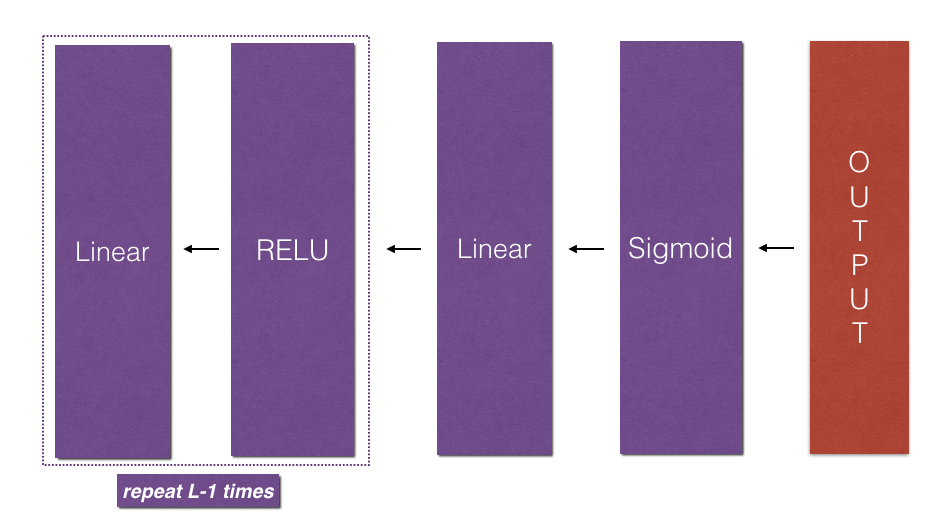
初始化反向传播: 要通过这个网络进行反向传播,要知道输出是: 。你的代码需要计算:
。你的代码需要计算: 。
。
使用下面公式:
dAL = - (np.divide(Y, AL) - np.divide(1 - Y, 1 - AL)) # derivative of cost with respect to AL. -(Y / AL - (1 - Y) / (1 - AL))
推导如下:
前向传播:

反向传播:
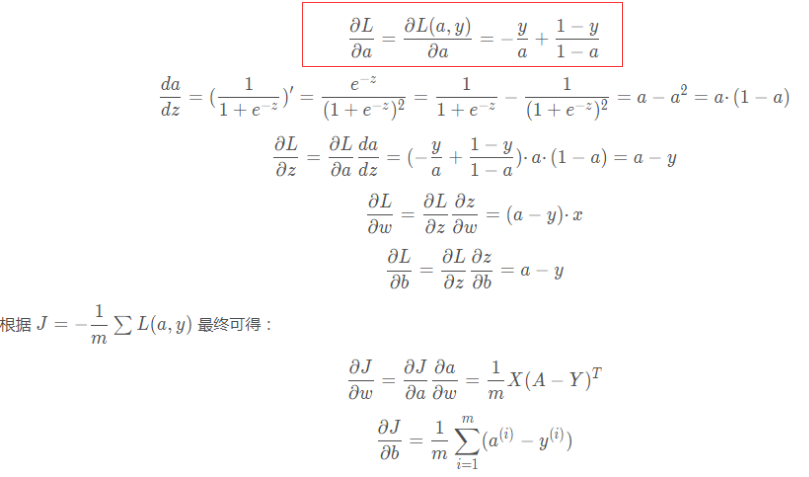
你可以用这个 dAL 来保持进行后向传播。现在,你可以使用 dAL 在 Linear-->Sigmod后向传播函数中(使用由L_model_forward函数产生的cache值)。
然后,你不得不使用 一个循环来迭代每一层,使用Linear-->Relu后向传播函数。
存储每一个 dA_prev, dW, db在 grad字典中,用下列公式:$grads["dW"+str(l)] = dw^{[l])$
Exercise: 实现后向传播 ([LINEAR->RELU] × (L-1) -> LINEAR -> SIGMOID model)
def L_model_backward(AL, Y, caches):
"""
Implement the backward propagation for the [LINEAR->RELU] * (L-1) -> LINEAR -> SIGMOID group
Arguments:
AL -- probability vector, output of the forward propagation (L_model_forward())
Y -- true "label" vector (containing 0 if non-cat, 1 if cat)
caches -- list of caches containing:
every cache of linear_activation_forward() with "relu" (there are (L-1) or them, indexes from 0 to L-2)
the cache of linear_activation_forward() with "sigmoid" (there is one, index L-1)
Returns:
grads -- A dictionary with the gradients
grads["dA" + str(l)] = ...
grads["dW" + str(l)] = ...
grads["db" + str(l)] = ...
"""
grads = {}
L = len(caches) # the number of layers
m = AL.shape[1]
Y = Y.reshape(AL.shape) # after this line, Y is the same shape as AL
# Initializing the backpropagation
dAL = - (np.divide(Y, AL) - np.divide(1 - Y, 1 - AL))
# Lth layer (SIGMOID -> LINEAR) gradients. Inputs: "AL, Y, caches". Outputs: "grads["dAL"], grads["dWL"], grads["dbL"]
current_cache = caches[L-1]
grads["dA" + str(L-1)], grads["dW" + str(L)], grads["db" + str(L)] = linear_activation_backward(dAL, current_cache, activation = "sigmoid")
for l in reversed(range(L-1)):
# lth layer: (RELU -> LINEAR) gradients.
current_cache = caches[l]
dA_prev_temp, dW_temp, db_temp = linear_activation_backward(grads["dA" + str(l + 1)], current_cache, activation = "relu")
grads["dA" + str(l)] = dA_prev_temp
grads["dW" + str(l + 1)] = dW_temp
grads["db" + str(l + 1)] = db_temp
return grads
AL, Y_assess, caches = L_model_backward_test_case() grads = L_model_backward(AL, Y_assess, caches) print ("dW1 = "+ str(grads["dW1"])) print ("db1 = "+ str(grads["db1"])) print ("dA1 = "+ str(grads["dA1"]))
Expected Output
| dW1 | [[ 0.41010002 0.07807203 0.13798444 0.10502167] [ 0. 0. 0. 0. ] [ 0.05283652 0.01005865 0.01777766 0.0135308 ]] |
| db1 | [[-0.22007063] [ 0. ] [-0.02835349]] |
| dA1 | [[ 0.12913162 -0.44014127] [-0.14175655 0.48317296] [ 0.01663708 -0.05670698]] |
6.4 - Update Parameters(更新参数)
在这个任务,使用梯度下降来更新参数:
 (α是学习率,在更新参数后,存储他们在参数字典中。)
(α是学习率,在更新参数后,存储他们在参数字典中。)
Exercise: 实现 update_parameters() 来更新参数。
Instructions: 在每一个  ,使用梯度下降来更新参数
,使用梯度下降来更新参数
# GRADED FUNCTION: update_parameters
def update_parameters(parameters, grads, learning_rate):
"""
Update parameters using gradient descent
Arguments:
parameters -- python dictionary containing your parameters
grads -- python dictionary containing your gradients, output of L_model_backward
Returns:
parameters -- python dictionary containing your updated parameters
parameters["W" + str(l)] = ...
parameters["b" + str(l)] = ...
"""
L = len(parameters) // 2 # number of layers in the neural network
# Update rule for each parameter. Use a for loop.
### START CODE HERE ### (≈ 3 lines of code)
for l in range(L):
parameters["W" + str(l+1)] = parameters["W" + str(l + 1)] - grads["dW" + str(l + 1)] * learning_rate
parameters["b" + str(l+1)] = parameters["b" + str(l + 1)] - grads["db" + str(l + 1)] * learning_rate
### END CODE HERE ###
return parameters
parameters, grads = update_parameters_test_case() parameters = update_parameters(parameters, grads, 0.1) print ("W1 = "+ str(parameters["W1"])) print ("b1 = "+ str(parameters["b1"])) print ("W2 = "+ str(parameters["W2"])) print ("b2 = "+ str(parameters["b2"]))
Expected Output:
| W1 | [[-0.59562069 -0.09991781 -2.14584584 1.82662008] [-1.76569676 -0.80627147 0.51115557 -1.18258802] [-1.0535704 -0.86128581 0.68284052 2.20374577]] |
| b1 | [[-0.04659241] [-1.28888275] [ 0.53405496]] |
| W2 | [[-0.55569196 0.0354055 1.32964895]] |
| b2 | [[-0.84610769]] |